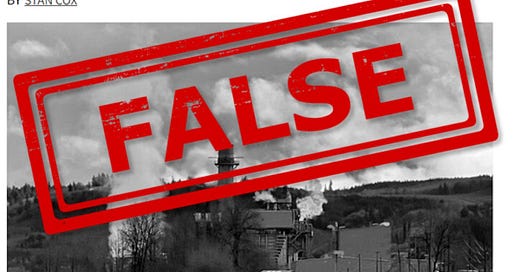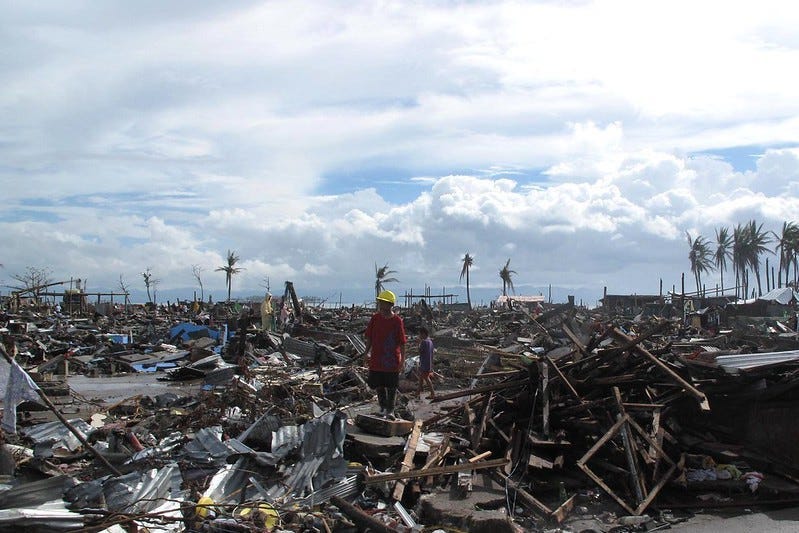Climate Change Worsened Extreme Weather Disasters That Claimed More Than Half a Million Lives – Study
Exaggeration is rarely a pretty sight.
Climate Change Worsened Extreme Weather Disasters That Claimed More Than Half a Million Lives – Study
World Weather Attribution’s 10-year anniversary analysis finds climate change influence in all ten deadliest weather disasters over the last two decades.
OCT 31
Wreckage from Typhoon Haiyan in the city of Tacloban, the Philippines in 2013. Credit: Russell Watkins/UK Department for International Development via Flickr, CC BY 2.0
One Earth Now is a reader-supported publication. To receive new posts and support my work, consider becoming a free or paid subscriber.
Human-caused climate change has exacerbated the ten deadliest extreme weather disasters since 2004, a new analysis finds.
From devastating tropical cyclones, rainstorms and floods to hellish heatwaves and droughts, these disasters together have resulted in more than 576,000 deaths. Researchers say the death tolls are certainly an undercount, and the influence of climate change in these deadly disasters shows how dangerous global heating already is at just 1.3°C (above preindustrial levels).
Continued planetary heating, caused primarily by fossil fuel combustion, will lead to many more deaths and massive damages as more intense and violent weather events smother and slam communities all across the world. Heating of up to 3.1°C is projected by the end of the century under current policies.
“If we keep burning oil, gas and coal, the suffering will continue” - Friederike Otto, climate scientist and lead at World Weather Attribution
The new study from scientists with World Weather Attribution marks 20 years since the publication of the first climate event attribution analysis and the 10-year anniversary of WWA’s formation. World Weather Attribution is an initiative started in 2014 to provide scientific insights into the role of climate change in extreme weather events, conducting rapid attribution analyses in the immediate aftermath of these events. Think of it as a climate change forensics team. Using methods like climate modeling, analyzing weather observations and combing through expert literature, these scientists are able to isolate and examine the influence of climate change in a range of complex extreme weather events.
What they find is that the fingerprints of climate change are detectable in these extreme events. In other words, in a world without the level of warming we see today, the kinds of monstrous storms and suffocating heat waves we’re seeing would not be as likely, and they would be less intense.
The new study looks at ten of the deadliest weather disasters – based on the International Disaster Database - since 2004, including three tropical cyclones in the Indo-Pacific, two heavy rainfall and flood events, four heatwaves in Europe, and a drought in the Horn of Africa. The study found that climate change made all of these ten disasters more intense and more likely, contributing to the deaths of at least 576,042 people.
“Climate change isn’t a distant threat. It worsened extreme weather events that left more than 570,000 people dead,” Friederike Otto, co-founder of World Weather Attribution and senior lecturer at the Centre for Environmental Policy, Imperial College London, said in a press release accompanying the study.
“If we keep burning oil, gas and coal, the suffering will continue,” she added.
Such statements of our climate crisis reality have become unequivocal and experts are issuing series of ever more dire warnings. The head of the UN Environment Program said last week in the latest UNEP Emissions Gap report that the Paris Agreement goal of limiting warming to 1.5°C could likely slip away within a few years and the even more dangerous 2°C “will take its place in the intensive care unit.” In another report, published this week by The Lancet, leading health and sustainability researchers say that “people in every country now face threats to their health and survival as climate hazards increase.” The reported findings in this year’s assessment of the health risks of climate change, the researchers say, are the most concerning yet. This Lancet report notably calls out fossil fuel companies that are expanding production and enabling emissions far above levels consistent with Paris Agreement goals, saying their strategies are “further threatening people’s health and survival.”
WWA Study Findings
Results from examining the ten deadliest weather events over the last 20 years show that conditions like high temperatures, heavy precipitation and wind speeds were made more likely or more intense by anthropogenic climate change:
~ Horn of Africa drought (2011) – The deadliest extreme weather and humanitarian disaster since 2004 occurred in one of the poorest regions of the world, where severe drought and subsequent crop failures contributed to widespread famine in Somalia that killed more than a quarter of a million people. “Combining evidence from past studies, we are confident that the deadly drought in 2011 was more intense due to human-induced climate change,” WWA researchers write in the new analysis.
~ Cyclone Nargis in Myanmar (2008) – This tropical cyclone brought winds exceeding 100 mph, heavy rainfall, and 12-foot storm surges to the low-lying area, resulting in more than 138,000 deaths. The storm’s high wind speeds and drenching rains were more likely and more intense, and the elevated sea surface temperatures that helped fuel the storm were about 47% more likely, with climate change.
~ Russian heatwave (2010) – The intense heatwave in western Russia, compounded with wildfires burning around Moscow, killed more than 55,000 people across the country. Researchers find the extreme temperatures seen in the heatwave were about 83 to 140 times more likely under anthropogenic climate change.
~ European heatwaves (2015, 2022 and 2023) – Following the 2003 European heatwave that killed 70,000 people and that gave rise to the first extreme event attribution paper published in 2004, deadly heatwaves have continued to impact the continent. A 2015 heatwave killed 3,275 people in France, and the high temperatures in that event were at least twice as likely given climate change. In the 2022 heatwave that killed more than 53,500 people, climate change increased the likelihood of seeing such high one-day temperatures by a factor of 9 and two-day temperatures by a factor of 17, researchers estimate. And in the 2023 heatwaves that resulted in over 37,100 deaths, the extreme temperatures observed in the western Mediterranean would have been impossible without climate change.
~ Storm Daniel in Libya (2023) – Climate change helped make the torrential rainfall in this storm more likely and more intense. Over 12,300 fatalities were reported, with most of the deaths in Libya occurring after two dams collapsed.
~ Typhoon Haiyan in the Philippines (2013) – This powerful storm led to widespread destruction and more than 7,000 deaths. The storms ingredients and enabling factors – rainfall, wind speeds, and sea surface temperatures – were made more likely and more intense or warmer with climate change.
~ India Floods (2013) – Heavy rains and flash floods in the Indian state of Uttarakhand killed more than 6,000 people; climate change made such an event twice as likely and the rainfall about 11% more intense.
~ Cyclone Sidr in Bangladesh (2007) – This cyclone resulted in more than 4,000 deaths. Attribution analyses find that climate change increased the likelihood of the observed wind speeds by 18% and the high sea surface temperatures by 47%, and the storm’s rains were also made more likely and more intense by climate change.
The new WWA study adds to a growing body of evidence and understanding that climate change is affecting all parts of the world, rich and poorer nations. Nowhere is really safe. The United States saw this recently with the one-two punch of Hurricanes Helene and Milton. Helene, which killed more than 230 people and was the deadliest storm to make landfall on the US mainland in nearly 20 years, demonstrated that even inland areas like Asheville, North Carolina that were once considered safe havens from climate disasters are not immune from devastating impacts. World Weather Attribution rapid analyses found that climate change helped worsen both of these hurricanes.
“Hurricanes Milton and Helene underscored the importance of attribution science. Just days after the storms battered the US, scientists pinpointed how climate change made them wetter, windier, and more destructive,” Joseph Giguere, a research technician at Climate Central and co-author of the new WWA report, said in the press release.
Slashing Emissions and Saving Lives
The researchers emphasize that proactive adaptation and resiliency measures can help save lives during a time of climate emergency.
“Every country needs to prepare for the future. Investing in early warning systems, updating outdated infrastructure and reorienting our policies to support the most vulnerable are key actions that can drastically reduce the impacts of extreme weather,” said Roop Singh of the Red Cross Crescent Climate Centre and study co-author.
Some extreme events are so unprecedented or rare that they are virtually impossible to prepare for, suggesting there are limits to adaptation and underscoring the importance of mitigating greenhouse gas emissions.
“Ultimately, we need to cut emissions,” Singh said. “With every fraction of a degree of warming, we will see more record-breaking events that push countries to the brink, no matter how prepared they are.”
That is a key takeaway message from this new WWA analysis, the researchers say – the urgency of slashing emissions and transitioning away from fossil fuels.
“Burning fossil fuels causes climate change, and climate change causes death and destruction,” Otto told journalists this week during a press briefing. “We need to stop burning fossil fuels.” She said she would like to see the transition away from fossil fuels, agreed to for the first time during the COP28 UN climate summit last year, actually get a timeline coming out of the upcoming COP29 summit so that there is something to hold countries accountable to in their updated Nationally Determined Contributions (NDCs) or climate pledges that are due by February 2025.
“This study is another reminder of what's at stake at COP29,” Joyce Kimutai, researcher at the Centre for Environmental Policy, Imperial College London and study co-author, said in the press release. “COP29 has to accelerate the transition away from fossil fuels, the primary reason we are now experiencing such dangerous weather.”
“This study should be an eye-opener for political leaders hanging on to fossil fuels that heat the planet and destroy lives,” Otto said. “We have the technology and knowledge to replace fossil fuels with renewable energy, lower demand and build a safer, healthier world. But, we need political leaders to step up and make it happen.”








Climate change did not worsen any extreme weather disaster.
Mankind multiplying, building more infrastructure, becoming more affluent, causes disasters to become more costly, in loss of life and money.
Fossil fuels are a blessing in that they enable mankind to protect itself.
May fossil fuels stay around for a long time still until we have enough nuclear capacity to replace them.
Otto said… war on fossil fuels. Who pays him?
We need leaders ya all got the green scam going
Up in toxic smoke like the NE Missouri Town evacuates due to a battery plant fire.